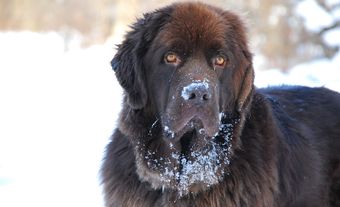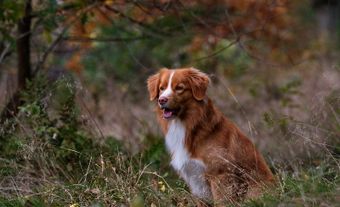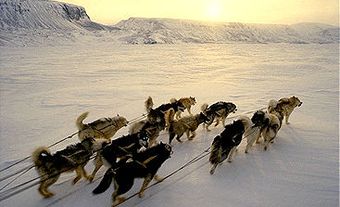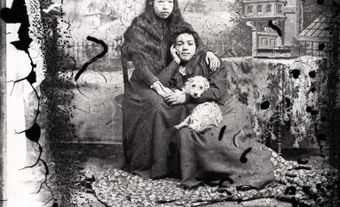The Labrador retriever is one of four remaining Canadian dog breeds (see also Dogs in Canada). Its history begins at the turn of the 16th century on the island of Newfoundland. Here, its ancestors were retrievers of fish and game. The breed was further developed in England in the 19th century to assist in hunting. With a friendly temperament, the Labrador retriever is popular not only as a working dog but also as a family dog. In Canada, the Labrador has been the most popular dog for more than 25 years.

Appearance
The Labrador retriever is a medium-sized dog with a strong, well-balanced build. It has a wide skull and is broad through the chest and loins, with strong hindquarters. Females measure 55–60 cm at the shoulder and weigh 25–31.5 kg. Males measure 57–62 cm and weigh 27–34 kg.
Their coat can be solid black, yellow or chocolate. Characteristic to the breed is a short, dense and fairly hard to the touch outer coat, and a soft, water-resistant undercoat. Other distinctive traits are webbed feet that help them swim and their “otter” tail, thick at the base and tapering toward the tip, used like a rudder to steer in water.
Origin and History of the Breed
The origin of the Labrador retriever is not fully known. However, it is widely accepted that a variety of European breeds contributed to its genetic makeup. Since the arrival of John Cabot in 1497, fishermen from European countries such as Portugal, Spain, France, Ireland and England sailed to Newfoundland to catch fish. A mix of dogs from Europe made it to Newfoundland on fishermen’s vessels or were brought by explorers and colonists in the 16th and 17th centuries. It is believed that water dogs, spaniels, hunting and herding dogs intermingled on the island ; over time, a local race, which is now extinct, developed through natural selection: the St. John’s water dog. In its early days, the St. John’s water dog did not have a specific appearance. However, two main types seem to have been prevalent: a large, long-coated dog and a smaller, short-coated one. The larger dog is thought to be the predecessor of the Newfoundland dog, while the smaller one that of the Labrador retriever.
The Labrador retriever was initially known as the Lesser Newfoundland or the St. John’s dog. In the early 1800s, British sportsmen and members of the British aristocracy noticed the St. John’s dog’s retrieving abilities, which were superior to other retrieving breeds. Consequently, the St. John’s dog started being imported in England. Two British families — the Earls of Malmesbury and the Dukes of Buccleuch — were major contributors to selectively breeding the St. John’s dog for hunting. The genetic lines of the modern Labrador retriever can be traced back to the kennels of these British aristocrats.
Near the end of the 19th century, however, both Newfoundland and England passed legislation that made the import of St. John’s dogs to England nearly impossible. In 1885, Newfoundland adopted the Sheep Protection Act, which allowed electors to prohibit dogs in their district. As a result, the number of St. John’s dogs dwindled on the island. At about the same time, in an attempt to keep rabies away, Great Britain passed the Quarantine Act. It required that imported dogs have a licence and go through a six-month quarantine before entering the country. Despite restrictions, the Labrador retriever survived due to the efforts of breeders in England and it was further developed by crossing it with other sporting dogs. By the 1880s, the Labrador was a highly appreciated hunting dog in Great Britain. It was first recognized as a breed by the Kennel Club of England in 1903, and by the Canadian Kennel Club in 1905.

Origins of the Breed’s Name
The Labrador retriever is not indigenous to Labrador, as its name may suggest. Both the Labrador and the Newfoundland dog originated on the island of Newfoundland. “Labrador,” the name of the region and dog breed, is thought to have evolved from the Portuguese word lavrador (small landowner or farmer), used by Portuguese explorers who navigated the coastlines of these regions since the turn of the 16th century.
Another hypothesis is that the Labrador retriever was named after a Portuguese livestock guardian dog, Cão de Castro Laboreiro, who was seemingly brought to Newfoundland by Portuguese fishermen. Based on the resemblance between the Labrador and the Castro Laboreiro, some believe that the latter contributed to the genetic makeup of the Labrador, whose name may be an adaptation of the word laboreiro.
Purpose
Listed by the Canadian Kennel Club as a sporting dog, the Labrador used to exclusively be a retriever of fish and game. Fishermen initially used the breed to pull nets from the water and retrieve fish that escaped from nets or slipped off hooks. On a stormy day, a Lab could retrieve close to 45 kg of fish from the sea.
Once it arrived in England at the beginning of the 19th century, the Labrador was selectively bred for hunting for approximately 100 years.
The Labrador is among the top breeds that work as service dogs, assisting the blind and the disabled, and as therapy dogs. Successful in scent-detection work, Labradors are also used to find drugs and explosives for the police, border and custom agencies, fire departments and the military. It is also used as a search and rescue dog, finding trapped or missing people. The breed has shown abilities in detecting cancer and other health issues in humans by identifying specific odors.

Temperament and Traits
A love for water, willingness to retrieve and eagerness to please its owner are some of the defining traits of the breed. They are also well-known for their intelligence, eagerness to learn and trainability. Gentle, friendly, fun-loving, enthusiastic and outgoing, the Labrador retriever is also a great family pet.

 Share on Facebook
Share on Facebook Share on X
Share on X Share by Email
Share by Email Share on Google Classroom
Share on Google Classroom







